Quick Links
New employees are eager to make a difference when they start. However, the old-fashioned onboarding process is filled with endless paperwork. This can lead to unnecessary delays and frustration, especially for those starting in remote working positions.
Here’s where electronic signatures for HR come in. A powerful tool to streamline the digital onboarding process, boost efficiency, and ensure compliance, ultimately enhancing the entire recruitment experience.
Benefits of using e-signatures in HR onboarding

Traditional paper-based onboarding programs are slow, prone to errors, and requires physical presence for handwritten signatures on documents containing personal information.
Electronic signature platforms for HR departments offer a wealth of benefits:
- Faster Onboarding: No more printing, signing, scanning, and mailing documents. Employees can review and sign documents digitally from anywhere, at any time, on any device. This significantly speeds up the onboarding process, getting new team members productive faster.
- Improved Efficiency: HR document signing becomes effortless. Imagine the time saved by eliminating paper trails and manual tracking! HR professionals can focus on more strategic tasks, enhancing the employee experience (EX). This can include spending more time on mentoring new hires, especially those in customer service roles, to ensure they are prepared to deliver exceptional service from day one.
- Enhanced Security: Electronic signatures for HR ensure document security with encryption and audit trails. This minimizes the risk of lost paperwork containing personal information, like background check results, and unauthorized access.
- Streamlined Compliance: E-signatures comply with the ESIGN Act in the United States, ensuring the legal validity of signed documents containing personal information. This simplifies compliance with I-9 verification and other HR regulations, adhering to the Electronic Transactions Act (UETA) and similar legislation.
- Reduced Costs: Eliminate printing, scanning, and mailing costs associated with paper documents. Electronic signature solutions for HR departments can offer significant cost savings in the long run.
- Improved Candidate Experience: A quicker, more user-friendly onboarding process creates a positive first impression for new hires. This can boost employee engagement and retention.
- Save time and resources: Streamlining employee onboarding with e-signatures saves HR professionals valuable time and resources. New hires can complete the onboarding process faster and more conveniently, from any location. They can have a smoother transition into their new roles, even the remote workers. This fosters a more positive company culture right from the start, where new hires feel welcome and supported.
Benefits of using electronic signatures for HR document management
Electronic signatures for HR offer a powerful solution for managing onboarding documents in the digital age. Here’s how they streamline business processes:
- Centralized Digital Repository: Say goodbye to overflowing filing cabinets! E-signatures allow you to create a secure, central location for all your signed onboarding documents. This makes it much easier to find and access any document you need, whenever you need it. No more digging through stacks of paper or wondering where a specific form might be filed.
- Enhanced Document Security: With traditional paper documents, there’s always a risk of loss, damage, or unauthorized access. Electronic signatures address this concern by employing encryption and access controls. This ensures that only authorized personnel can view or modify your documents, minimizing the chances of a security breach.
- Simplified Document Sharing: Sharing onboarding documents with new hires can be a hassle with physical copies. E-signatures enable online secure document sharing. You can easily send documents to new hires digitally, ensuring they receive the latest versions. This eliminates the risk of errors or outdated information that can occur with physical copies.
- Version Control: Gone are the days of worrying about misplaced or outdated documents. Electronic signatures provide a clear audit trail, showing exactly who signed what document and when. This ensures everyone is working with the most recent version of a document, reducing confusion and errors.
- Streamlined Workflows: E-signatures can be integrated with your existing HR software, allowing you to design automated workflows for specific onboarding documents. This eliminates manual tasks like routing paper documents for handwritten signatures and simplifies the overall onboarding process.
By implementing electronic signatures for HR document management, you can experience a more organized, secure, and efficient system. This translates to significant time savings for HR professionals and a smoother onboarding experience for new hires.
Best practices for e-signatures in HR

Here are some key tips to ensure a smooth and successful implementation of electronic signatures for HR:
Choose the Right Platform
Select an electronic signature platform for HR departments that meets your specific needs. Consider e-signature platforms that are easy to use, have security features, integrations with existing HR software, and scalability. Look for platforms that can also facilitate employee self-service onboarding, allowing new hires to complete some onboarding tasks independently. This HR automation further streamlines the recruitment process and frees up HR professionals for more strategic work.
Develop a Clear Policy
Set clear guidelines for how electronic signatures will be used in your digital HR onboarding process. This should cover things like making sure documents are legit, keeping a record of who signed what, and how long you’ll store personal information.
Educate Employees
Train employees on how to use the electronic signature software. This ensures smooth adoption and minimizes confusion.
Integrate with Existing Systems
To make things run even smoother, connect your electronic signature solution to the HR software you already use, like applicant tracking systems or onboarding platforms. This way, everything works together seamlessly.
Ensure Compliance
Stay updated on relevant regulations regarding electronic signatures in your state. Legal considerations of e-signatures for HR are important. While the ESIGN Act provides a legal framework for electronic signatures in the USA, some states may have additional regulations. Be sure to research the specific laws in your jurisdiction to ensure compliance.
How to implement e-signatures for HR documents
Implementing electronic signatures for HR is a straightforward process:
- Research and Choose a Solution: Evaluate different electronic signature solutions for HR departments based on your needs and budget. Choose a sotware that can cover more than one service and consider options that enable employee self-service onboarding.
- Set Up Your Account: Once you choose a solution, create an account and configure user access for HR personnel and new hires.
- Develop Workflows: Design workflows for specific onboarding documents like offer letters, tax forms, and confidentiality agreements. Include workflows for employee benefits enrollment documents as well.
- Integrate with Existing Systems: Connect your electronic signature solution to the HR software you already use, like applicant tracking systems or onboarding platforms. This way, everything works together seamlessly for the HR team.
- Train Employees: Provide training for HR staff and new hires on using the electronic signature software.
- Start Signing!: Begin using the system for your onboarding process. Monitor usage and make adjustments as needed.
How e-signatures improve compliance in HR paperwork
Electronic signatures aren’t just a convenient way to ditch the paper chase. They also play a crucial role in ensuring your HR department adheres to important regulations.
Here’s how e-signatures for HR strengthen your compliance efforts:
- Compliance with E-SIGN Act: E-signatures make sure your documents are legally binding in the US. There’s a federal law called the E-SIGN Act that says electronic signatures are just as good as handwritten ones. This means no more worries about whether a signed document will hold up in court.
- Enhanced Audit Trails: E-signatures leave a clear digital record showing exactly who signs what document and at what time. This is like a paper trail, but way easier to track! This helps with things like I-9 verification, where you need to prove new hires are who they say they are and can legally work. With an audit trail, you can easily show officials that all the right documents are signed by the right people.
- Reduced Risk of Errors: E-signatures come with a built-in timestamp, so you never have to worry about losing track of paperwork or accidentally using outdated documents. This reduces the chances of mistakes that could cause compliance problems down the road.
- Improved Record-Keeping: Electronic documents with e-signatures are easier to store and organize compared to physical paperwork. This helps HR departments maintain records easily. It also ensures that all signed documents are accessed easily for audits or future reference.
By implementing electronic signatures, HR professionals can be confident they are meeting compliance requirements while also streamlining document management processes.
Conclusion
Switching to electronic signatures for HR can completely revamp your onboarding process, making it quicker, easier, and safer for everyone involved, from HR professionals to new hires.
Electronic signatures represent a key step towards digital transformation in HR.
The benefits extend beyond onboarding, improving document management, compliance, and overall HR operations in the digital age. Electronic signatures represent a key step towards digital transformation in HR.
Curious to learn more? WayMore’s experts are ready to chat!
FAQs
You typically obtain an official e-signature through an e-signature service that creates a unique digital signature for you. E-signature platforms like WayMore.io can help you with that.
While typing your name can be part of the process, a true e-signature involves additional security measures beyond just text. These measures are provided by e-signature platforms, like WayMore.io
Yes, employment agreements can be electronically signed with e-signatures that are legally valid under the E-SIGN Act (US).
E-signatures use encryption and audit trails to ensure document security and prevent unauthorized access to confidential HR documents.
E-signature services employ various methods like digital certificates to verify the signer’s identity and prevent forgery.
E-signatures offer comparable legal validity to wet signatures while providing faster processing, improved security features, and easier document management.
Our comprehensive guide dives into the E-Signature vs. Wet Signature debate, exploring benefits, security, legality, and the future of e-signing.
The cost of e-signatures for HR varies depending on features and volume. Research e-signature service providers to find options that fit your budget.
WayMore.io e-signature platform offers a flexible pay-as-you-go option, charging a specific price per signed document.
This allows you to avoid subscriptions and only pay for what you need.




